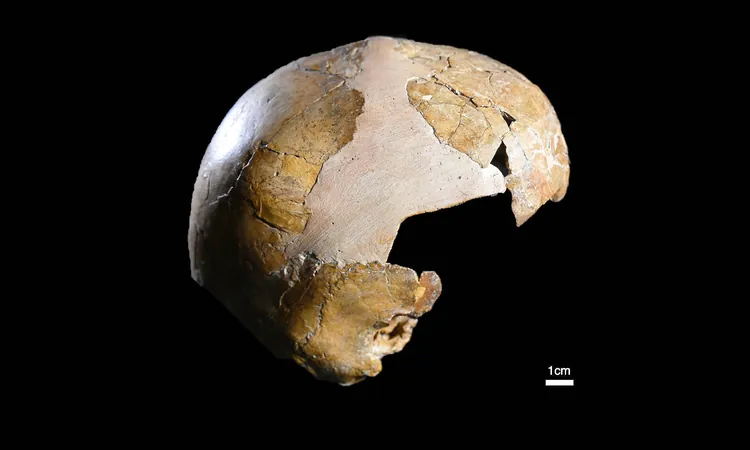
Ancient Hybrid Child: The Key to Understanding Human-Neanderthal Interbreeding
2025-08-29
Author: Ying
A Groundbreaking Discovery in a Hidden Cave
Nearly a century ago, a child's skeleton was unearthed from the depths of Skhul Cave, nestled in the rugged terrain of Mount Carmel, Israel. But recent re-analysis has unveiled a major revelation — this ancient relic is likely a hybrid of Homo sapiens and Neanderthal traits.
Fossil Features Point to a Unique Ancestry
Dating back roughly 140,000 years, the child's skull and jaw showcase a striking blend of characteristics from both species. Researchers now believe this fossil represents the earliest known anatomically modern human with a combination of these ancestral traits, indicating potential early interactions between human populations in the Levant.
Modern Science Meets Ancient Bones
Led by Professor Israel Hershkovitz from Tel Aviv University and Anne Dambricourt-Malassé from France's CNRS, an international team utilized cutting-edge imaging techniques to re-examine the Skhul I child. Their analysis revealed that while the braincase retains the smooth, rounded shape typical of modern humans, the jawline lacks a pronounced chin and displays dental patterns more commonly associated with Neanderthals. This absence of a chin is significant in paleoanthropology, as it is often used to distinguish our species.
Genes Tell a Story of Interbreeding
“Genetic studies over the past decade have shown that these two groups exchanged genes,” explained Professor Hershkovitz. Many people today, particularly those outside Africa, carry a trace of Neanderthal DNA, suggesting a mix happened around 50,000 to 60,000 years ago. The team also analyzed inner ear structures, identifying features consistent with Neanderthals, further supporting this hybrid theory.
The Significance of the Skhul Child
The Skhul I child isn't just another fossil; it could redefine our understanding of early human burials. Skhul and nearby Qafzeh caves are known for their evidence of intentional burials, hinting at complex social behaviors amongst Pleistocene inhabitants. If this child truly represents a hybrid, it implies that early formal burials may not solely belong to a single human lineage.
A Broader View of Human Evolution in the Levant
The Levant region has emerged as a historical convergence zone. Findings from the Nesher Ramla site in 2021 revealed a diverse population with a mix of traits, suggesting repeated interactions among ancient groups. This context makes a hybrid child like the Skhul I easier to envision within a broader narrative of population dynamics.
Scientific Controversies and Future Directions
Despite the exciting findings, some skeptics remain. Paleoanthropologist Chris Stringer argues that the bones primarily align with Homo sapiens, suggesting the evidence for hybrid ancestry isn't definitive. Clear answers could come through ancient DNA analysis, but retrieving such data, especially in warmer climates, remains challenging.
To further unravel this mystery, researchers advocate for additional studies using advanced techniques on other skeletal remains from Mount Carmel. By expanding on this groundwork, we could gain valuable insights into the cultural and genetic interplay among ancient populations.
What Lies Ahead for Hybrid Research?
Only time, and more genetic evidence, will allow scientists to determine whether the Skhul I child was a first-generation hybrid or a product of long-term gene flow among neighboring populations. With the potential for new findings on ancient genome data, the story of our ancestors continues to evolve.



 Brasil (PT)
Brasil (PT)
 Canada (EN)
Canada (EN)
 Chile (ES)
Chile (ES)
 Česko (CS)
Česko (CS)
 대한민국 (KO)
대한민국 (KO)
 España (ES)
España (ES)
 France (FR)
France (FR)
 Hong Kong (EN)
Hong Kong (EN)
 Italia (IT)
Italia (IT)
 日本 (JA)
日本 (JA)
 Magyarország (HU)
Magyarország (HU)
 Norge (NO)
Norge (NO)
 Polska (PL)
Polska (PL)
 Schweiz (DE)
Schweiz (DE)
 Singapore (EN)
Singapore (EN)
 Sverige (SV)
Sverige (SV)
 Suomi (FI)
Suomi (FI)
 Türkiye (TR)
Türkiye (TR)
 الإمارات العربية المتحدة (AR)
الإمارات العربية المتحدة (AR)